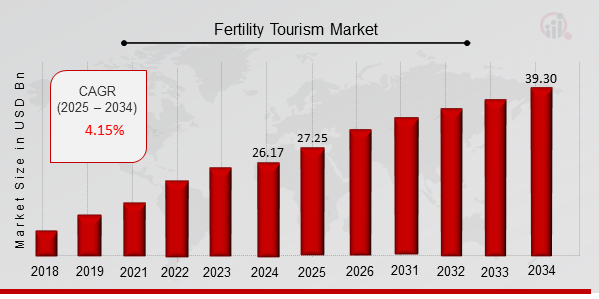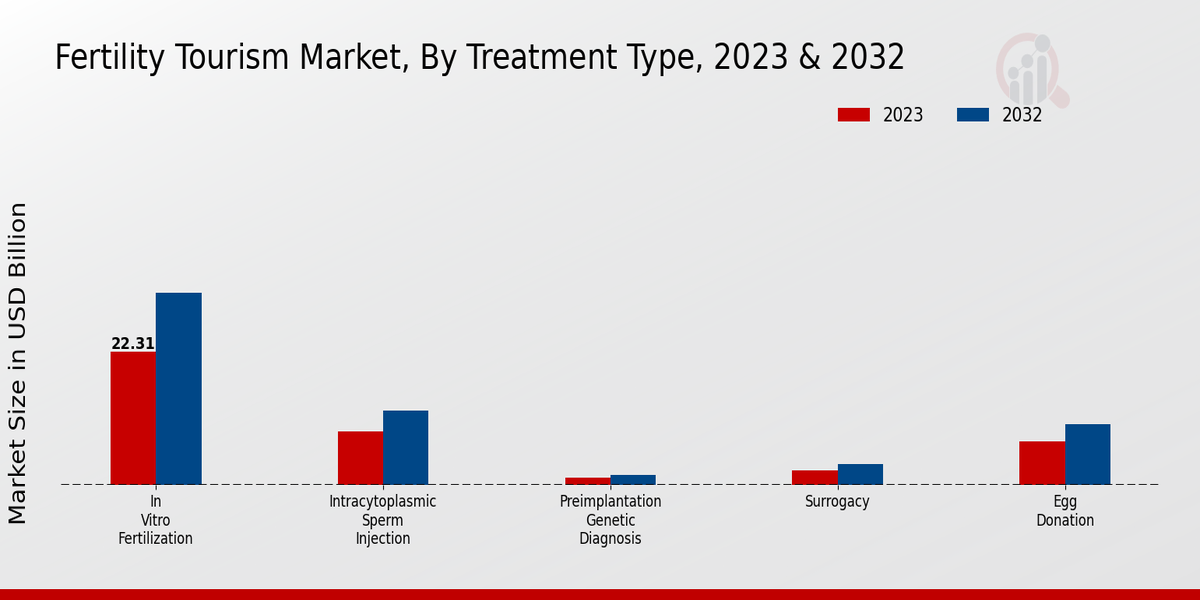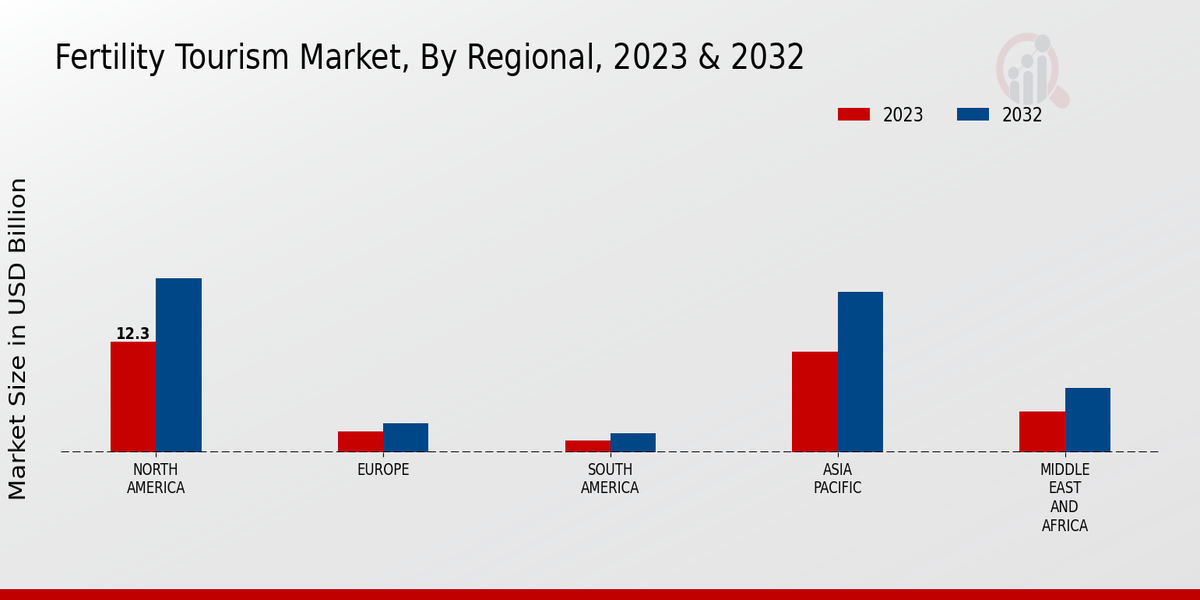Fertility Tourism Market Overview
As per MRFR analysis, the Fertility Tourism Market Size was estimated at 26.17 (USD Billion) in 2024. The Fertility Tourism Market Industry is expected to grow from 27.25 (USD Billion) in 2025 to 39.30 (USD Billion) till 2034, at a CAGR (growth rate) is expected to be around 4.15% during the forecast period (2025 - 2034).
Key Fertility Tourism Market Trends Highlighted
The Fertility Tourism Market is expanding rapidly, fueled by advancements in reproductive technologies and increasing demand for infertility treatments. Key drivers include the rising prevalence of infertility, delayed childbearing due to societal and economic factors, and the availability of affordable and accessible fertility treatments.
Recent trends include the emergence of personalized fertility care, the use of advanced genetic testing, and the growth of surrogacy and egg donation services.
Opportunities exist in expanding access to fertility treatments in underserved regions, developing innovative technologies to improve outcomes, and addressing the legal and ethical implications of fertility tourism.

Source Primary Research, Secondary Research, MRFR Database and Analyst Review
Fertility Tourism Market Drivers
Rising Infertility Rates
Infertility is a growing problem around the world, and this is one of the major factors driving the growth of the fertility tourism market. Many factors contribute to infertility, including - Age As women get older, their fertility declines.
Lifestyle factors Smoking, drinking alcohol, and being overweight or obese can all contribute to infertility. Environmental factors Exposure to certain chemicals and toxins can also lead to infertility. The rising infertility rates are expected to continue in the coming years, which will further drive the growth of the fertility tourism market.
According to a report by the World Health Organization (WHO), infertility affects approximately 1 in 4 couples worldwide. In developed countries, the infertility rate is even higher, with approximately 1 in 5 couples experiencing infertility.
The rising infertility rates are creating a growing demand for fertility treatments, such as in vitro fertilization (IVF) and intrauterine insemination (IUI). Fertility tourism offers couples access to these treatments at a lower cost than they would pay in their home country.
This is making fertility tourism an increasingly attractive option for couples who are struggling to conceive.
Increasing Awareness of Fertility Treatments
The increasing awareness of fertility treatments is another major factor driving the growth of the fertility tourism market. In the past, many people were unaware of the different fertility treatments available to them.
However, thanks to the internet and social media, people are now more informed about fertility treatments and their success rates. This increased awareness is leading more couples to seek out fertility treatments, including those who live in countries where access to these treatments is limited or expensive.
Fertility tourism offers couples a way to access affordable, high-quality fertility treatments in a safe and supportive environment.
Government Support for Fertility Treatments
In some countries, the government provides financial support for fertility treatments. This is another factor that is driving the growth of the fertility tourism market. For example, in the United Kingdom, the government provides funding for up to three cycles of IVF treatment for couples who meet certain criteria.
Government support for fertility treatments is making it more affordable for couples to access these treatments. This is leading to an increase in the number of couples who are seeking fertility treatments, including those who live in countries where government support is not available.
Fertility Tourism Market Segment Insights
Fertility Tourism Market Treatment Type Insights
The Fertility Tourism Market segmentation by Treatment Type comprises In Vitro Fertilization (IVF), Intracytoplasmic Sperm Injection (ICSI), Preimplantation Genetic Diagnosis (PGD), Surrogacy, and Egg Donation. Among these, IVF held the dominant share in 2023 and is projected to maintain its dominance throughout the forecast period.
IVF involves fertilizing an egg outside the body and implanting the resulting embryo into the uterus, offering higher success rates compared to other methods. The growing prevalence of infertility issues, advancements in IVF techniques, and increasing awareness about fertility preservation are expected to drive the growth of the IVF segment.
Surrogacy, where another woman carries and delivers the baby for intended parents, is also gaining popularity due to factors such as medical conditions that prevent a woman from carrying a pregnancy, same-sex couples seeking parenthood, and the availability of advanced surrogacy regulations in certain countries.

Source Primary Research, Secondary Research, MRFR Database and Analyst Review
Fertility Tourism Market Patient Origin Insights
The Patient Origin segment provides insights into the geographical distribution of patients seeking fertility treatments. North America holds a significant market share due to advanced medical infrastructure, high disposable income, and supportive government policies.
Europe follows closely, driven by a large patient pool and well-established healthcare systems. Asia-Pacific is expected to witness substantial growth, attributed to rising disposable incomes, increasing awareness, and government initiatives.
Latin America and the Middle East and Africa are emerging markets with growing demand for fertility tourism, owing to improving healthcare facilities and increased access to advanced treatments. These regions present opportunities for market expansion and investment.
Fertility Tourism Market Destination Country Insights
The United States dominates the Fertility Tourism Market, accounting for over 40% of the market share. This is due to the country's advanced medical infrastructure, high-quality healthcare providers, and favorable legal framework for fertility treatments.
Spain is another major destination for fertility tourists, with a market share of around 20%. Spain offers a wide range of fertility treatments at competitive prices, and its proximity to other European countries makes it a convenient destination for patients.
Mexico and India are also popular destinations for fertility tourism, due to their low costs and high success rates.
Thailand is another emerging destination for fertility tourism, offering a range of affordable and high-quality treatments.
Fertility Tourism Market Age Group Insights
The age group segment of the Fertility Tourism Market holds significant importance in understanding the market dynamics. Data indicates that the age group of 25-34 years accounts for a sizable share of the market, driven by factors such as increasing awareness about fertility treatments and the desire to have children at a younger age.
This age group typically has a higher fertility rate and is more likely to seek fertility treatments if needed. The 35-44 years age group also represents a substantial segment of the market, as individuals in this age range may face challenges conceiving naturally and turn to fertility tourism for assistance.
Additionally, the 45-54 years and 55 years and above age groups contribute to the market demand, albeit to a lesser extent, as fertility rates decline with age and alternative options may be considered.
Understanding these age group segments enables market players to tailor their services and offerings to meet the specific needs and preferences of each group, thereby driving market growth and industry revenue.
Fertility Tourism Market Regional Insights
The Fertility Tourism Market showcases regional diversity in market growth and landscape. North America leads the market with a substantial share, driven by advanced medical infrastructure, high disposable income, and supportive regulatory frameworks. Europe follows closely, with countries like Spain, Germany, and the UK being major destinations for fertility treatments.
APAC is poised for significant growth, fueled by rising demand for assisted reproductive technologies in countries such as India, China, and Singapore. South America and MEA are emerging markets with growing demand for fertility tourism, driven by increasing awareness and accessibility of treatments.

Source Primary Research, Secondary Research, MRFR Database and Analyst Review
Fertility Tourism Market Key Players and Competitive Insights
Major players in the Fertility Tourism Market are constantly striving to gain a competitive edge by offering innovative and advanced treatments, expanding their global presence, and forming strategic partnerships.
Leading Fertility Tourism Market players are investing heavily in research and development to introduce new technologies and procedures that can improve patient outcomes and enhance the overall fertility tourism experience.
The Fertility Tourism Market development is driven by factors such as rising infertility rates, increasing awareness about assisted reproductive technologies (ART), and growing disposable income in developing countries.
A leading company in the Fertility Tourism Market is IVI RMA Global, a global network of fertility clinics with a presence in over 50 countries. IVI RMA Global offers a wide range of fertility treatments, including IVF, ICSI, PGD, and surrogacy.
The company has a team of experienced fertility specialists and embryologists who provide personalized treatment plans to patients. IVI RMA Global is committed to providing high-quality fertility care and has a success rate of over 70%.
A competitor company in the Fertility Tourism Market is Eugin Clinic, a leading fertility clinic in Europe with clinics in Spain, the UK, and Sweden. Eugin Clinic offers a comprehensive range of fertility treatments, including IVF, ICSI, PGD, and egg donation.
The clinic has a team of highly skilled fertility specialists and embryologists who are dedicated to providing personalized care to patients. Eugin Clinic has a success rate of over 65% and is known for its innovative treatments and excellent patient outcomes.
Key Companies in the Fertility Tourism Market Include
- IVFMD
- Pacific Fertility Center
- ConceiveAbilities
- Extend Fertility
- Nurture Fertility
- RMA of New York
- ORM Fertility
- Aspire Fertility
- InVia Fertility
- Shady Grove Fertility
- CNY Fertility
- Fertility Institutes
- Boston IVF
- Illume Fertility
- HRC Fertility
Fertility Tourism Market Developments
The rising infertility rates, advancements in assisted reproductive technologies (ART), and increasing awareness about fertility treatments are driving market growth.
Key industry developments include the launch of innovative fertility treatments, strategic partnerships between fertility clinics and travel agencies, and government initiatives to support fertility tourism.
North America and Europe currently dominate the market, while Asia-Pacific is expected to witness significant growth in the coming years due to increasing disposable income and improved access to healthcare.
Fertility Tourism Market Segmentation Insights
Fertility Tourism Market Treatment Type Outlook
- In Vitro Fertilization (IVF)
- Intracytoplasmic Sperm Injection (ICSI)
- Preimplantation Genetic Diagnosis (PGD)
- Surrogacy
- Egg Donation
Fertility Tourism Market Destination Country Outlook
- United States
- Spain
- Mexico
- India
- Thailand
Fertility Tourism Market Age Group Outlook
- 25-34 years
- 35-44 years
- 45-54 years
- 55 years and above
Fertility Tourism Market Regional Outlook
- North America
- Europe
- South America
- Asia Pacific
- Middle East and Africa
| Report Attribute/Metric |
Details |
|
Market Size 2024
|
26.17 (USD Billion)
|
|
Market Size 2025
|
27.25 (USD Billion)
|
|
Market Size 2034
|
39.30 (USD Billion)
|
|
Compound Annual Growth Rate (CAGR)
|
4.15 % (2025 - 2034)
|
|
Report Coverage
|
Revenue Forecast, Competitive Landscape, Growth Factors, and Trends
|
|
Base Year
|
2024
|
|
Market Forecast Period
|
2025 - 2034
|
|
Historical Data
|
2020 - 2024
|
| Market Forecast Units |
USD Billion |
| Key Companies Profiled |
IVFMD, Pacific Fertility Center, ConceiveAbilities, Extend Fertility, Nurture Fertility, RMA of New York, ORM Fertility, Aspire Fertility, InVia Fertility, Shady Grove Fertility, CNY Fertility, Fertility Institutes, Boston IVF, Illume Fertility, HRC Fertility |
| Segments Covered |
Treatment Type, Patient Origin, Destination Country, Age Group, Regional |
| Key Market Opportunities |
Growing awareness Assisted reproductive technologies Surrogacy options Egg donation services Legalization of surrogacy |
| Key Market Dynamics |
Strict regulations, technological advancements, rising infertility rates, increased awareness, and growing medical tourism. |
| Countries Covered |
North America, Europe, APAC, South America, MEA |
Frequently Asked Questions (FAQ) :
The Fertility Tourism Market was valued at USD 24.12 billion in 2023.
The Fertility Tourism Market is projected to grow at a CAGR of 4.15% from 2025 to 2034.
North America is expected to dominate the Fertility Tourism Market by 2034.
Rising infertility rates, advancements in reproductive technologies, and increasing disposable income are key factors driving the growth of the Fertility Tourism Market.
Major applications of Fertility Tourism include IVF, surrogacy, and egg donation.

















